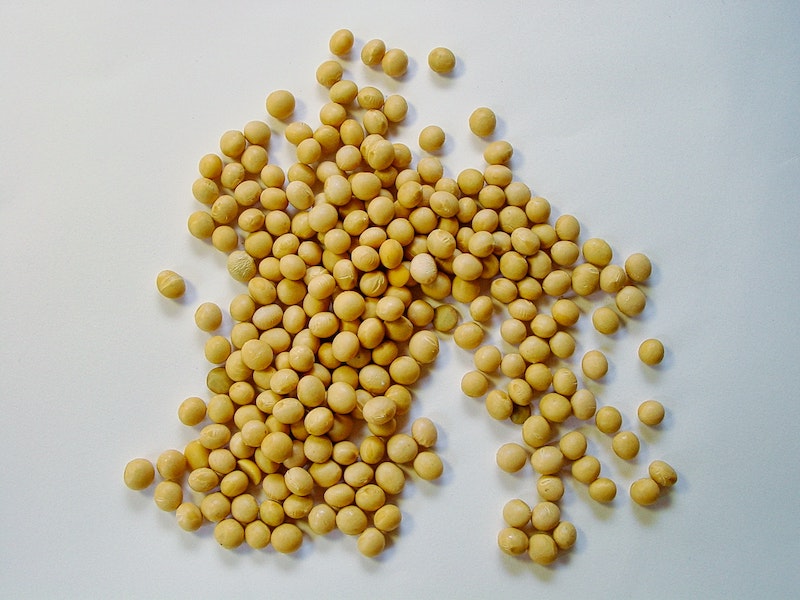What Exactly Is Soy Lecithin? Advantages vs. Risks

Soy lecithin has been a topic of conversation online over the past few years. But what exactly is it? Why is it so popular, and should you be concerned if you're consuming it?
We will get into the ins and outs of soy lecithin in this blog post, including what it is, its benefits, and its drawbacks. We will talk about why it has become so popular and whether eating it is bad for your health. Continue reading to discover more about this enigmatic food ingredient!
What is soy lecithin?
Soy lecithin is a substance that's derived from soybeans. It's found in various foods, including salad dressings, ice cream, and chocolate. Some people also use it as a dietary supplement.
There are some potential advantages associated with soy lecithin. For example, it may help to protect the liver and lower cholesterol levels. Additionally, soy lecithin may improve cognitive function and memory.
On the other hand, soy lecithin supplements are not without their share of potential side effects. For example, they may contain unhealthy fats and chemicals.
Additionally, soy lecithin supplements may interact with certain medications. Therefore, speaking with a healthcare provider before taking them is essential.
Soy lecithin can be found in several foods due to its use as an emulsifier, including salad dressings, vegan cheese, and ice cream recipes. Still, it is also popularly used as a supplement for its health benefits, like improved cognitive function and liver protection/detoxification.
Some people also put it on their skin as a skin care product or an anti-inflammatory when they have acne or eczema. It helps calm irritated skin while restoring the epidermis' moisture balance.
The history of soy lecithin
A natural emulsifier made from soybeans is called soy lecithin. It has been used as a food additive for many years in Asia and is now commonly utilized in the United States.
French pharmacist and chemist Maurice Gobley was the first to isolate soy lecithin in 1884. He found that when heated, soybeans release a chemical that can make oil and water mix. This substance was later named lecithin by the German chemist Oscar Liebreich.
Soy lecithin comprises linoleic acid, oleic acid, stearic acid, and palmitic acid, among other fatty acids. These fatty acids are what give soy lecithin its unique emulsifying properties.
Soy lecithin is commonly used as an additive in processed foods. It can be found in chocolate, margarine, salad dressings, and baked goods. Because it has a lot of essential fatty acids, soy lecithin is also used as a supplement.
There are some concerns about the safety of soy lecithin due to its soy content. However, most of the soy used to produce soy lecithin is GMO-free. Additionally, soy lecithin does not contain any allergens in soybeans.
How is soy lecithin made?
Soy lecithin is a product that is derived from soybean oil. It is a thick, yellow substance used in many processed foods as an emulsifier, stabilizer, or lubricant.
The primary component of soy lecithin is phosphatidylcholine, a phospholipid type. All living cells contain phospholipids, which are necessary for cell membranes. They also participate in various biological activities, including cell signaling, metabolism, and signal transduction.
Soy lecithin is manufactured by extracting oils from soybeans. The resulting mixture is then refined and purified to remove impurities. The final product typically contains between 30 and 50% soybean oil.
The advantages of soy lecithin
Soy lecithin is used in many ways in the food, cosmetics, and drug industries. It is also a good emulsifier. It is derived from soybeans and is safe for most people to consume.
Soy lecithin has some advantages over other emulsifiers. Since it is not eliminated from the body and does not promote the growth of hazardous germs, it is less likely to induce allergic reactions than other oils. Soy lecithin can also improve the texture of food products and extend their shelf life.
Even though soy lecithin is generally considered safe, some people may have side effects like stomach pain or headaches. These side effects are typically mild and resolve on their own.
The risks of soy lecithin
Soy lecithin has been linked to digestive, thyroid, and reproductive problems. Soy lecithin is generally considered safe, but there are some risks you should know about before eating it.
- Digestive Issues: Soy lecithin can cause digestive upset in some people. Stay away from soy lecithin if you have a sensitive stomach or a history of stomach problems.
- Thyroid Problems: There is some evidence that soy lecithin might make the thyroid gland work less well. If you have existing thyroid problems, you should avoid soy lecithin.
- Reproductive Issues: Soy lecithin may also disrupt the normal functioning of the reproductive system. Some studies have shown that soy lecithin can reduce sperm motility and viability. If you are trying to conceive, try to avoid soy lecithin.
How to use soy lecithin
Soy lecithin comes from soybeans and is a byproduct of the soybean oil manufacturing process. It's a natural source of phospholipids essential for human health. The cell membranes in our bodies are made of phospholipids, which are also needed for the cells to work right.
Soy lecithin is available in supplement form and is added to some food products as an emulsifier. You can find it in margarine, chocolate, and non-dairy coffee creamer. It's also a lubricant, a release agent in baking, and an additive in cosmetics and paints.
Soy lecithin should be taken daily in doses of 1200 mg. It may be consumed with or without meals. If you're taking it as a supplement, it's best to take it in divided doses throughout the day.
There are few side effects associated with soy lecithin supplementation. The most common is diarrhea, which typically goes away after a few days of taking the supplement. Stop taking soy lecithin and see a doctor if you suffer any other adverse effects.
Sunflower lecithin vs. soy lecithin: Which is better?
Sunflower lecithin and soy lecithin are both sources of phospholipids, which play an essential role in human health. They both have similar benefits, such as aiding digestion and reducing inflammation. However, there are also some differences between them.
Most people think sunflower lecithin is better because it has more polyunsaturated fatty acids. It also contains more phosphatidylcholine, which is beneficial for cognitive function. There are more antioxidants in sunflower lecithin, which can help prevent cell damage from free radicals.
On the other hand, soy lecithin contains phytoestrogens, which have been linked to some health concerns. Soy lecithin may also have traces of GMOs and pesticides, depending on where it comes from.
Overall, sunflower lecithin is generally considered the healthier option for most people. However, both types of lecithin can be beneficial if taken in moderation.
Why is lecithin in chocolate?
Lecithin is a natural emulsifier that helps bind fat and water together in chocolate. It helps create a creamy texture, prevents the separation of cocoa butter and other ingredients, and makes it easier to work with chocolate when melting and molding.
Lecithin also helps reduce viscosity, which helps keep chocolate from becoming too thick or sticky. Lecithin also keeps chocolate from turning into crystals, which makes it last longer.
Most manufacturers use soy lecithin as an emulsifier in chocolate. However, some manufacturers use sunflower lecithin or other plant-based emulsifiers as well.
Soy lecithin alternatives
If you want to avoid using soy lecithin, another option would be egg yolk lecithin, which is naturally derived from eggs rather than from plants like soybeans, thus making it suitable for vegan/vegetarian-friendly folks who wish not to consume plant-based products (especially those suspecting they have sensitivities).
But remember that buying only high-quality egg yolk supplements still means carefully reading the labels to ensure they don't have any extra additives or nasty ingredients and then formulating companies themselves.
Conclusion
Soy lecithin is a byproduct of making soybean oil. Its effects on health are uncertain. Before making any decisions about eating or using this product, it's essential to keep an open mind and research since soy lecithin's effects on people have yet to be studied well enough. As with anything else, moderation is vital regarding soy lecithin.

